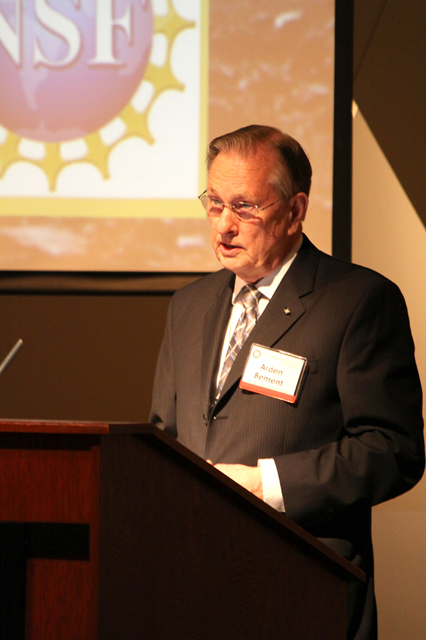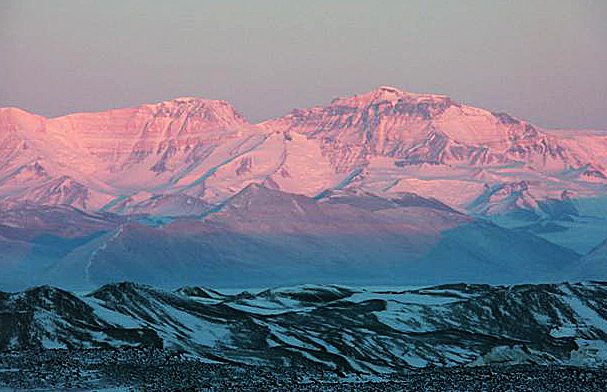Antarctic Treaty meetingConference of polar experts, diplomats covers topics from IPY to tourismPosted April 24, 2009
Scientists, diplomats and others involved in supporting research in Earth’s polar regions converged in Baltimore, Md., this month for the 32nd Antarctic Treaty Consultative Meeting The first such meeting hosted in the United States since 1979, the event marked the 50th anniversary of the signing of the historic international treaty that preserved the continent for peaceful, scientific pursuits. U.S. Secretary of State Hillary Rodham Clinton “The genius of the Antarctic Treaty The treaty was signed in 1959 by the 12 nations that participated in Antarctica during the International Geophysical Year (IGY) The International Polar Year (IPY) 
Photo Credit: Patricia Pooladi/ National Academy of Sciences
Arden Bement, director of the National Science Foundation.
Arden Bement “It may be the next generation of scientists, or even the one after that, that first realizes the full significance of results obtained by scientists in IPY,” he said. One immediate result, he added, will hopefully be more excitement about science in the younger generations. “This may be the impetus for them to become scientists in the years to come.” David Holland “The science isn’t quite there yet. We’re getting there,” said Holland, one of six leading polar scientists to speak during the IPY ceremony on April 6. “I really think with our international partners we can solve this, but the hard part is about the doing … If we decide we want to solve the problem, we can do that.” The history of the Antarctic Treaty itself is certainly one of perseverance and small miracles, according to Dian Belanger, a historian who wrote a seminal book about the IGY, Deep Freeze: The United States, the International Geophysical Year, and the Origins of Antarctica’s Age of Science Seven of the original 12 nations that signed the treaty had territorial claims, Belanger noted during a phone interview. In the final days of negotiations, after about 18 months of discussions, Argentina still balked at the idea of suspending its sovereignty, she said. New Zealand finally resolved the stalemate by suggesting the treaty reflect the model established during the IGY. The exact words from the treaty in Article II state: “Freedom of scientific investigation in Antarctica and cooperation toward that end, as applied during the International Geophysical Year, shall continue, subject to the provisions of the present Treaty.” Noted Belanger, “Nobody forgot their political interests, but science provided a way to work around, even through, them.” The treaty has grown to include 47 signatory countries, representing two-thirds of the world’s peoples. Treaty members have adopted a number of other agreements over the years, including the Convention for the Conservation of Antarctic Marine Living Resources The latter agreement protects the Antarctic environment through five specific annexes on marine pollution, fauna and flora, environmental impact assessments, waste management and protected areas. It prohibits all activities relating to mineral resources except for scientific research. “They couldn’t have done that in 1959,” Belanger said of the 50-year ban on mineral exploitation. “But [treaty negotiators] set up the treaty in such a way that they would have treaty meetings every year or two like the one now going on in Baltimore, so they could take up issues that might come up after the fact or that were beyond the capabilities of the diplomats and politicians at the time.” One of those present-day issues was Antarctic tourism, which has grown tremendously in recent years. In 2007-08, about 46,000 people visited the Antarctic by land or sea, a sevenfold increase since 1992-93, according to the International Association of Antarctic Tour Operators Clinton said on April 6 that the United States had submitted a resolution that would place limits on landings from ships carrying large numbers of tourists. “The United States is concerned about the safety of the tourists and the suitability of the ships that make the journey south,” she said. The resolution comes after a recent spate of tourist ship mishaps around the Antarctic Peninsula. In 2007, a tourist ship carrying 154 passengers and crew struck an iceberg 50 miles off the coast and sank. No one was hurt. During the most recent tourist season, two ships ran aground in unrelated incidents, though both vessels were later able to return to port in Argentina. Clinton concluded her remarks to the assembled crowd with an upbeat message. “So, in the spirit of the treaty and in light of the incredible discoveries that took place during the International Polar Year, let us resolve to keep making progress with sharp research and bold action on both ends of our planet, in the south and the north, for the good of our nations and for the people, but mostly for this beautiful planet we currently share and the succeeding generations that should have the same opportunity to enjoy its bounty and its beauty.” |



For USAP Participants |
For The Public |
For Researchers and EducatorsContact UsU.S. National Science FoundationOffice of Polar Programs Geosciences Directorate 2415 Eisenhower Avenue, Suite W7100 Alexandria, VA 22314 Sign up for the NSF Office of Polar Programs newsletter and events. Feedback Form |


